Winching Techniques
The Power of the Winch
Use a winch not only to get unstuck, but also to remove objects and to climb or descend extremely steep hills.
A winch takes the work out of freeing a vehicle. Also a vehicle can free itself with a winch.
However, never use the winch to lift or move people or to lift objects.
Winching requires an anchor
Other vehicles can be used as anchors, but natural objects such as trees,stumps and rocks are best. Select the anchor carefully and ensure it can withstand the load.
The tow ball on any vehicle is never an acceptable recovery point.
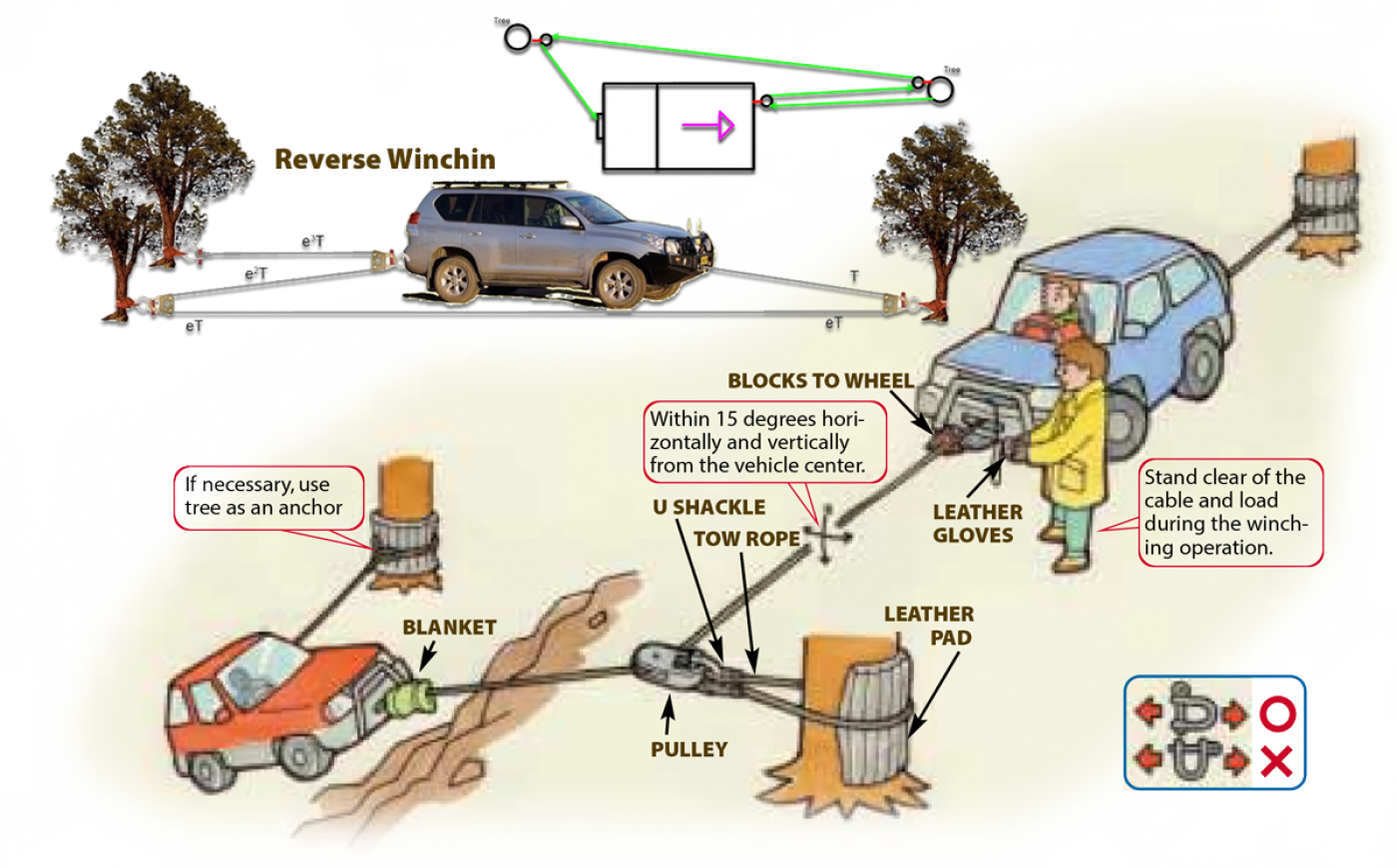
Winch operation
Depending on the weight of the object to be moved, decide the number of pulleys, length of rope, how to hook the cable (e.g. single/ double/triple line) and the direction of pulling.
When anchoring the pulling vehicle, engage the parking brake and put blocks in front of the wheels.You may find that pressing on the foot brakes adds further stability.
If needed, use an additional anchor for stability or to prevent flipping the vehicle.
Wrap the anchor with a leather pad. Also place a blanket in the middle of the cable when winching.
If possible,start the engine of the stuck vehicle and shift to neutral. Keep the wheels pointing straight to the pulling direction.
Start the engine of the winching vehicle and begin to pull.
Snatch Block
A snatch block is a massively strong pulley that reroutes the cable on a winch pull. Placing the vehicles side-by-side allows one vehicle to pull another without having to be in a direct line with their winch. Get your geometry pants on for this kind of pull. As most kits will include something like a 25,000 lb. rated snatch block, it’s a good idea to know how to use them. The most simple application is to pull from other angles that would be impossible to perform in a straight line.
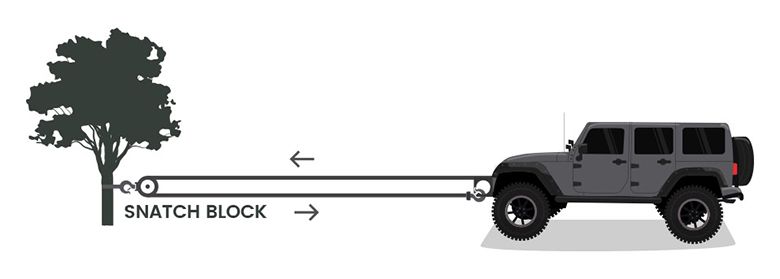
Essentially, the snatch block splits the weight of the load you’re pulling across all of the lines as they’re doubled back. For example, using a single snatch and hooking the line back to the winching vehicle “doubles” the power, or splits the load across the two lines. Using two snatch blocks can triple or quadruple the amount of force depending on the setup. There’s no limit to the number of blocks you can use for a pull, so long as you don’t overload your weakest piece of equipment.
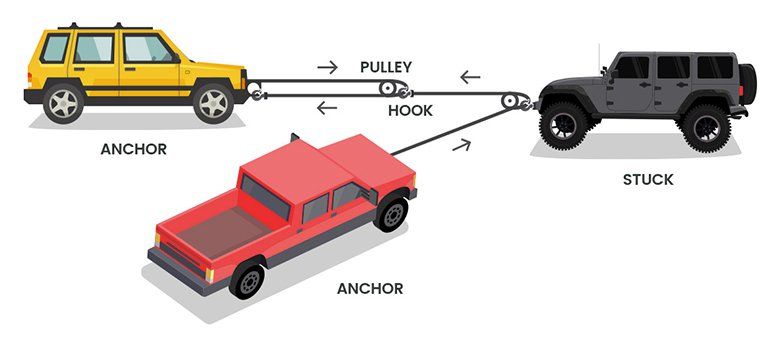
In the graphic, we can see that there are two anchor vehicles performing a recovery of a stuck vehicle resembling a Jeep. Even though the stuck vehicle appears to be expensive and well-outfitted, it is in fact not rated to handle the kind of terrain in this demonstration. The yellow vehicle resembling a Range Rover understands that it doesn’t have the weight or the winching power to move the stuck vehicle so they’ve contacted a good friend that owns a large pickup truck resembling a Ford.
Unfortunately, the red pickup doesn’t have a winch outfitted to their vehicle, but it does have rated factory tow hooks. So a static line or cable can be used in the connection from the red truck, to the jeep and doubled back to the snatch block in the center of the image. The most common setup for this configuration is usually a winch on the red truck, but there are plenty of options here. The Range Rover then simply feeds the winch line out, passes through a snatch block and doubles back to a recovery point on the same truck. The Range Rover in this illustration is the only vehicle performing work in this equation and produces the capacity of 4x the rated power of its winch.
High Angle Recovery
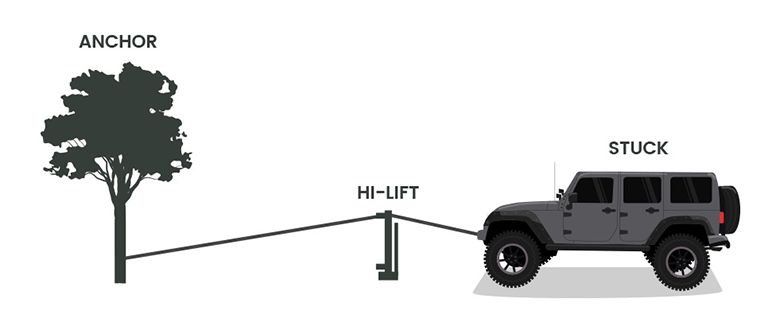
We’re going to illustrate the Hi-Lift maneuver that I’m such a huge fan of and we’re going to touch on a few other things that will help keep your suspension in one piece during a winch pull. This doesn’t need to get too technical as we’ve already covered it in some regards and the rest should be pretty intuitive.
If your vehicle is stuck in very deep mud or you need to winch up and over an obstacle, a winch can help you do more damage than assistance. On very steep inclines, you’ll want to get the winch anchor point set really high up in the air. This will require large trees usually, as this is quite a tall order, no pun intended. Consider your options for high mounting points before pulling. This will ensure that you’re not adding shear stress onto your suspension components and will prevent your winch lines from giving up in the middle of the fight.
This is equally true for pulling a vehicle from the mud. We’ve mentioned previously that it’s quite simple to find videos online that show the undercarriage being ripped clean from trucks by much larger trucks. High mounting points for your winch will help to break the suction created by thick mud. If the mud pit is really soupy, it’s probably not a big deal, but you want to be sure that the angle of your winch line is at a reasonable angle to permit the vehicle to be pulled up and out of the pit.
However, when the mud is beginning to dry the dynamic changes dramatically. Thick mud creates this kind of suction around the wheels of the truck and keeps them locked in place. Choosing the high angle of attack will help considerably in getting the vehicle moved.
If a high mounting point isn’t an option, you can create an artificial one using a Hi-Lift Jack, thick logs, large rocks, etc. The thing to remember in this regard is going to be the weight limit of the Hi-Lift bar. They typically don’t like numbers above 5000 lbs. and may break the cast iron ladder bar if things get too intense. The front of a truck likely isn’t going to exert enough force to break the Hi-Lift if you’re driving in a controlled manner. This is definitely a stunt that I’d reserve as a last resort in some of these scenarios. On steep climbs, for instance, you’re going to be on the throttle pretty good and this can create a more dangerous situation for your vehicle, gear and bystanders.
Rollover Recovery
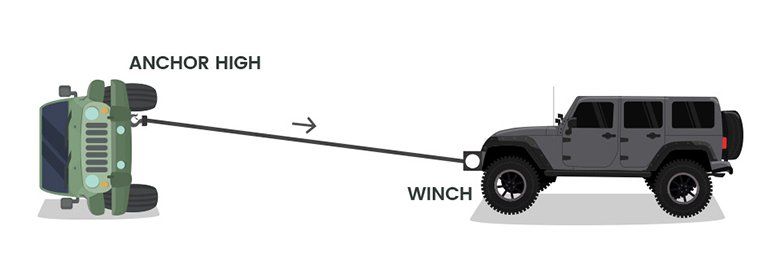
Don’t do this.
Above is a simplified illustration that’s probably unnecessary and also dangerous.
If you’ve rolled your vehicle on the trail and it’s possible to get a tow truck or another professional there to fix it, then you need to do that. That’s also a good idea of what the limitations of this exercise are going to look like. You can probably get your Jeep or Toyota back on its wheels and cruise out after a fuel reset procedure and checking the cylinders for oil/fuel excess.
So you’re not going to call a professional or you need to get out of a really bad situation, fine. Using any number of combinations of snatch blocks and vehicles with winches, set up a high anchor point somewhere on the frame or dedicated recovery point. The ideas here are quite simple. The vehicle rolled because the terrain is steep and the driver ran out of talent. When the vehicle comes back onto its wheels, that terrain will continue to be a player in this game. Often times, groups are more concerned with getting the truck back onto its wheels and they forget some of the most important things in a recovery.
First things first, you’re going to want your emergency brakes off, lockers disengaged and transmission in neutral. There’s going to be quite a bit of shock on the driveline when the truck bounces into a righted position. This is going to be really hard on your components and may very well break something. The problem with this is obvious; the truck is free to roll up or down the very obstacle that rolled it. It’ll be important to coordinate winching with a vehicle uphill of the recovery so that one winch can be used to right the vehicle and another can be used to maintain tension to keep the vehicle from rolling away.
It’s not uncommon to anchor all winching vehicles to trees, boulders, etc. If things go horribly wrong and the stuck vehicle gains any meaningful momentum, it can destroy equipment or take another truck with it. Use winches, extensions, snatch straps and more to ensure everyone is safe.
From this point, have someone mechanically inclined check out the engine and gearboxes to make sure nothing’s going to run dry or blow up. If oil has made it into the intake or cylinders, it’s a short matter of time before they bend a rod or blow a head gasket. Once the vehicle is determined to be safe for starting, fire it up and continue what you were doing. If she’s not going to run, then you’ll want to consider the difficult task of towing the vehicle out of there. Make good decisions.


